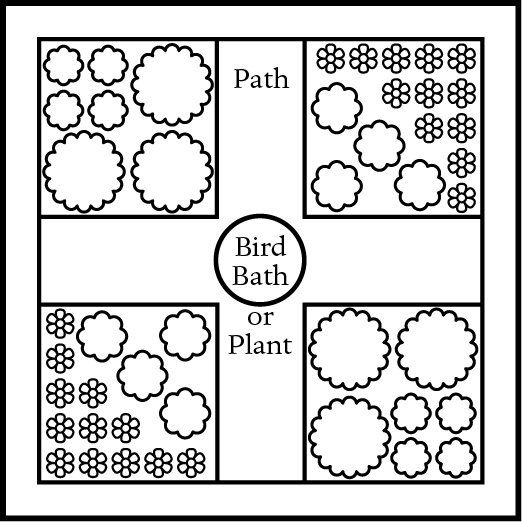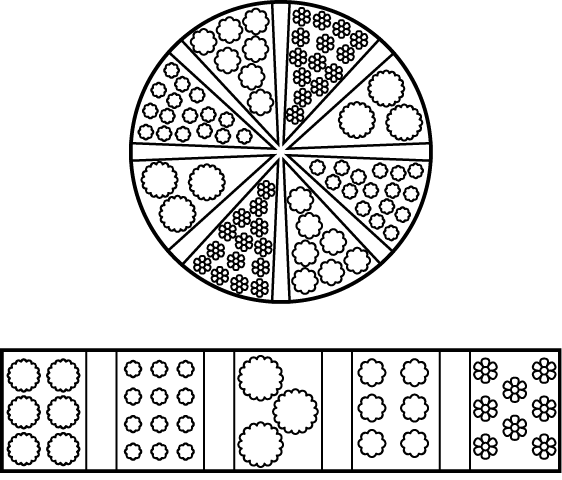Garden Design Past and Present
To me, the word garden conjures up an image of a beautiful, aromatic, and tranquil place to sit and enjoy nature. In this sense, an herb garden is not really different from a flower garden. It can be just as decorative and, of course, smell fabulous. An herb garden can be an attractive and peaceful place to sit or entertain, which contributes to a general sense of well-being and health. We can add whimsical, artsy, or traditional objects to create a style that suits our imaginations.
Even the smallest of herb gardens can be a place of beauty and fun. It can be formal like the classic Elizabethan knot garden, with an intricate design where plants seem to be woven together like strands of a decorative knot. Or it can be very informal like the English cottage style, which can seem like barely controlled chaos. An herb garden can be modern, traditional, or themed just like a flower garden. It can also be a separate garden or an herb “room” (area) within a flower garden. In addition, herbs can be integrated into existing gardens of flowers, shrubs, or vegetables. In fact, herbs are very beneficial to other plants, which we will explore later, but first let’s take a look at garden design.
The ancient Romans laid out their herb gardens in geometric patterns, making them practical and appealing. Medieval monastic gardens were rectangular with paths between rows of herbs and vegetables. Later, the artistic enthusiasm of the Renaissance extended to gardens. Geometric designs with squares and rectangles were worked into complex symmetrical patterns creating a living version of the Persian carpet. The Elizabethan era marked the dawn of extravagant pleasure gardens in royal courts as well as large estates. To disassociate their outdoor space from the cluttered appearance of cottager’s gardens, the landed gentry kept their plants neatly trimmed and formal. This and the influence of popular Italian design resulted in the knot garden. While knot gardens are absolutely beautiful, they take more work to set up and the plants must be kept neatly clipped to maintain the appearance. That said, if it is the garden of your dreams, it is worth the effort.

Figure 1.1. A formal look can be created by using geometric shapes with repeating form and color to unify the garden.
If a formal look appeals to you but you want a design that is less labor-intensive than a knot garden, the use of geometric patterns can help you achieve it. Geometric patterns can be created from a simple square-, rectangular-, or circular-shaped garden by putting paths between groups of plants. Paths can be created with gravel, stones, or bricks. Also, a traditional formal garden usually has something at the center to serve as a focal point. This can be a statue, gazing ball, potted plant, or anything that appeals to your sense of design. A birdbath works well, plus by inviting birds to your garden you are encouraging natural pest control.
A traditional informal design can be created by locating a garden along a wall or a fence with taller plants at the back and shorter ones in front. If you want to make an island and locate your garden in the middle of a lawn, arrange it with taller plants in the center and progressively shorter ones out to the edges. An island bed can be circular, oval, or kidney-shaped. It can also be a free-form garden with irregular, flowing borders. In addition, consider the shapes that can be created within the garden using plant colors and textures.
Layouts such as the ladder and cartwheel are popular designs for herb gardens. Bricks or small paving stones are often used to create the ladder rungs or wheel spokes. One type of herb is usually planted in each of the spaces.
An important hallmark of good design for any type of garden is having the plants easy to reach. Not only does this make planting easier, but tasks such as weeding and harvesting can be done without trampling half the garden. If you don’t want paths, a few flat stepping stones or bricks can be strategically placed to help you maneuver around the plants.
Another type of garden design is the raised bed, which has some advantages. In addition to being a solution for poor soil, it provides easy access to plants so you don’t need to put in paths or do as much bending while working. It also provides good drainage. Raised beds allow you to accommodate the herbs you want to grow even if your soil is not what they require. Also, if you have more than one raised bed you can use different types of soil and group plants with similar requirements together. The gardening project at my neighborhood elementary school creatively uses raised beds by grouping them into geometric patterns.
The frames for raised beds can be built with wood, bricks, or stones. If you make your own with wood, purchase the type that is untreated so chemicals won’t leach into the soil. Ready-made frames are also available. Once the frames are up it is easy to get started: pour in bagged soil, work in some compost, and you are ready to plant. My son and I used a raised bed to solve a landscape problem with our backyard. The property behind ours is a few feet higher and our yard sloped directly toward the house. To ease the slope, we installed a raised bed along the back fence by stacking long, heavy timbers to create a terrace. To keep the timbers aligned, my son connected them with long, thick screws. This terrace measures about two feet from front to back and creates a perfect border garden because it is easy to work in.
Don’t be shy about integrating herbs into your current landscaping. Bushy lavender plants can set off a path or highlight a decorative fence, and Roman chamomile can be used for ground cover in partially shaded areas. Also, herbs such as lemon balm and chervil can thrive in moderately moist areas where other plants may not fare as well.
Amongst the stones or bricks of paths and patios, low-growing herbs can enhance the stonework and help keep weeds at bay. A patio is a particularly good place for herbs because it is usually situated in a sunny location. Aromatic herbs will warm with the stonework and scent the air, creating a pleasant outdoor space. Creeping thyme and Roman chamomile work well for this.
As previously mentioned, herbs can be integrated into an established garden of vegetables, shrubs, and flowers. They can enhance the colors and scent of a garden, too. Also, many herbs are helpful in the vegetable garden as companion plants that attract beneficial insects and deter the bad ones.
Location, Location, Location
Now that you may have some creative ideas for your herb garden, it’s time to start the practical planning. If you are starting a garden from scratch, the first step is to figure out the best location for it. Go outside several times on the same day and take a look at your property. Note where is it sunny or shady. From memory, or over the course of several months, note from which direction your property gets the most wind and where frost or snow lingers. In addition, take note of areas where water may puddle. Also find out where water lines, electrical cables, septic tanks, or underground oil tanks may be buried. It’s not that you will be digging really deep, but keep in mind that when these services need repair or replacement, your garden will become a casualty. If possible, consider positioning the garden where you can see it from a window to extend your enjoyment of it.
Even if you are adding herbs to an existing garden, you will want to do some assessment. Check if the plants you already have could benefit from the herbs you are interested in growing and group them accordingly. And remember the importance of having planting areas that are easy to get at and work in. While the stars don’t always perfectly align to give us the best of everything, with some planning and ingenuity we can create a garden that suits our tastes and accommodates the plants’ requirements.
Why Scientific Names Are Important
While the common names for plants are easy to remember, they are a source of confusion because one plant may be known by a number of names. For example, the flower widely known as bleeding heart (Lamprocapnos spectabilis syn. Dicentra spectabilis) is also known as Dutchman’s trousers, lady in a bath, and lyre flower. And the blue flag (Iris versicolor) is also known as the northern blue flag, flag lily, and water lily. For this reason, it is important to know the scientific (genus and species) names when purchasing seeds, herbs, and essential oils. This way, you will be sure of getting the right ones.
Genus and species are part of a complex naming structure initiated by Swedish naturalist Carl Linnaeus (1707–1778). His work became the foundation for the International Code of Botanical Nomenclature. Over time, as new knowledge about plants emerged, their names were changed to reflect the new data. This is one reason why we find synonyms in botanical names. Antiquated names are kept to aid in identification, as in the example of the bleeding heart above. Another reason is scientific disagreement.
Most names are in Latin because during Linnaeus’s time Latin was a common language that people engaged in scientific research could share. The first of the two words in the scientific name is the genus, which is a proper noun and always capitalized. A plant’s species name is an adjective that usually provides a little description about the plant. The genus for yarrow is Achillea in honor of the Greek hero Achilles, and the species that is included in this book is millefolium. The word millefolium indicates a leaf of many parts (mille meaning “thousands” and folium meaning “foliage”). Occasionally you may see a third word in a name preceded with “var.” indicating that it is a variety of that species. For example, the naturally occurring white-flowered rosemary has the scientific name of Rosmarinus officinalis var. albiflorus. Sometimes a variety is referred to as a subspecies, however, this term is often regarded as a gray area.
A third word may also indicate a cultivar, or more appropriately, a cultivated variety. This type of plant was created in the garden and not found naturally in the wild. The cultivar name is written in single quotes. For example, Mentha spicata ‘Kentucky Colonel’ is a cultivated variety of spearmint. The more modern cultivar names are written in English instead of Latin. You may also see an “x” in a name and this indicates that the plant is a hybrid. Mentha x piperita, peppermint, is a naturally occurring hybrid between spearmint, Mentha spicata, and water mint, Mentha aquatica.
Following the two- or three-word name you may also see a letter or sometimes a name, which identifies the individual who named the plant. For example, an “L.” following a plant name means that it was bestowed by Linnaeus himself.
While it is not necessary to memorize the scientific names of the herbs with which you want to work, it is a good idea to jot them down to take with you when you go shopping for plants or essential oils. This way you can be sure to get the correct ones.
